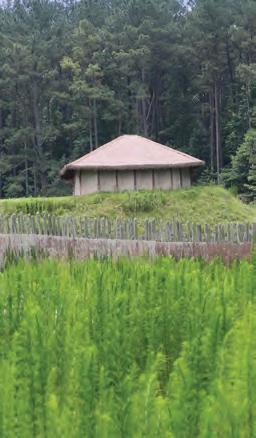
4 minute read
Carolina Gardens
from 2022-09-EU
LAUREN LIGHT
BY KEVIN COX
EnergyUnited Member
EnergyUnited members likely will be surprised to learn that some popular TV show music was made by a Davidson
County singer-songwriter,
Lauren Light.
Lauren Light’s voice is familiar to audiences who have heard her live shows for years, but her voice and music have travelled far beyond those performances through her extensive musical contributions to advertising, television shows, movies and more. Just a few examples include commercials for such companies as Nike, Hyundai and TJ Maxx, as well as TV series Abbott Elementary on ABC and Law & Order: SVU on NBC.
Since 2019, Light and two partners, Alex Helton and Chelsey Coy, have owned and operated twoOHsix Music. “It’s a full-service, one-stop music licensing agency,” said the 31-year-old Light, who earned a master’s degree in music business and songwriting from Berklee College of Music after graduating from North Davidson High School. Ad agencies, TV and film production companies and others reach out to twoOHsix for the music they need and the license to use it.
Light, who works from her home in northern Davidson County, and her LA-based partners are singers, songwriters, producers and musicians who create half of the music they license for use. The remainder comes from a sizable list of musical artists around the country who make their music available to twoOHsix for licensing.
“About half of my professional time is spent composing music,” Light said.
Often, twoOHsix provides music made exclusively for a client, as it did for 24 different commercials for Adidas’ recent “Support Is Everything” ad campaign for its sports bras. Custom music has also been provided for such TV series as “All American,” “Batwoman” and “4400” on The CW television network.
While Light enjoys travelling around the country as an artist and music business entrepreneur, she looks forward to many more years of creating music and growing her company from her family’s Davidson County home built long ago by her great-grandparents.
To learn more about Lauren, visit her website LaurenLight.com or follow her on Instagram
@Lauren_Light.

4 Methods to Make Your Own Unique Soap

Create handcrafted soaps for yourself or gift them to a friend
By Rue Reynold
Soapmaking can be a rewarding hobby to get into for gift-giving or a personal treat. To help get you started, here are four methods to create the soap of your dreams.
Melt and pour The melt and pour method is the easiest way to make soap. You buy a premade soap base, melt it down and then add color, fragrance or oil. Once it hardens, it’s ready to use. This is a great method for absolute beginners, children and those who are hesitant to work with lye (the solution used to make soap from scratch).
Cold process The cold process is the most common method for hobbyists because you have complete control over what goes in your soap and how it looks. This is a made-from-scratch process that’s done by mixing fats (oils and butters), sodium hydroxide lye, fragrance or color. Combining fats with lye begins a chemical reaction called saponification which breaks down the fats for them to bind with the lye. After setting the soap mixture aside, saponification and water evaporation can take up to 30 days or more for handmade soap to dry and reach its maximum mild state. Always be in a well-ventilated room and wear protective goggles and gloves when working with lye, which is a strong chemical that can burn skin or cause harm if the fumes are inhaled.
Hot process This method mirrors the cold process almost exactly, but rather than wait for saponification to complete on its own, you significantly speed it up by applying heat. While hot processed soap should also be allowed to set before using, it takes much less time to complete compared to cold processed soap. The downside to this method is not being able to easily design elaborate patterns. To learn more about hot process soapmaking, check out “Hot Process Soap Making” by Heidi Villegas. Milling Also known as French milling or hand milling, this method combines cold process, hot process and melt and pour. Soap is first made using either the cold process or hot process method. Once complete, the soap is grated and then melted as you add additional color, fragrances or ingredients.
Milling is often alternated with the term “rebatching” because they follow the same process, but they have different meanings. “Milling” indicates creating your own soap starting from the cold process or hot process method. “Rebatching” refers to reshaping an old soap, taking a premade commercial soap and adding your own spin to it, or fixing a soap that may not have gone as planned during the original cold process or hot process attempt.
No matter which method you choose, research and prepare thoroughly before attempting to make soap. Take each step one at a time and you’ll soon have a shelf (and gift bag) full of amazing handcrafted creations.
Rue Reynold is the editorial assistant for Carolina Country.





